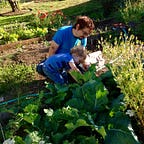Putting Potherbs In Their Place
Wild Foods Challenge, Day 6
For the month of June, I’ll be taking the Wild Foods Challenge and trying to incorporate more found and foraged edible ingredients in my diet. I hope you’ll follow along!
When you start dipping your toes into the stream of traditions encompassed by the word “foraging,” one of the phrases that will come up most often is “can be used as a potherb.”
Seriously, check out the Google Search:
In all of the literature, however, rarely does one come across a decent explanation of just what a potherb is.
One might think that it’s a plant that can be grown in a little pot, or a seasoning herb like basil or sage (insert obligatory Seattle ‘pot herb’ joke here, man). In fact, a potherb is any leafy green that can be cooked in a pot. “Cooked” is the key, here. Many potherbs would be too tough or bitter for a salad or sandwich, but added to a stew or soup? Excellent.
Potherbs make it super easy to incorporate wild foods into any dish you can think of. In many ways, it’s reasonable, if you see the phrase “can be used as a potherb,” to think “can be tossed into anything I’m cooking as an added vegetable.”
HOWEVER!
Not all potherbs were created equally!
Remember, wild foods are ingredients, and wild potherbs often have different characteristics that will impact the way they’re cooked. Knowing the family your potherb is in will give you a good idea of its culinary characteristics.
For example, last night’s incredibly simple meal included two handfuls of lovely wild orache (Atriplex spp. — one of a few possibilities, but they’re all edible to a degree):
This stuff is lambsquarters’ mildly salty, slightly chewier cousin. It can be found around the tide-line on local saltwater beaches.
It’s essentially the same as garden orache, which is in the spinach family (Amaranthaceae). The edible greens in this family tend to be delicate and “spinachy.” As a “potherb,” tossing it into a stew would result in losing the flavor of the leaves. Instead, I wilted it in a touch of olive oil and butter, and had it with feta over angel hair pasta (and a sprinkle of salal flower finishing salt):
It was sooooo good, and the preparation really allowed the plant to speak for itself as a star of the show.
I also recently harvested a lot of dock (Rumex spp.), one of my favorite wild edibles. Dock is a lot tougher than other wild greens, and can really take a nice, long, slow heating. Also, it’s a member of the Polygonaceae family, which also includes sorrels, buckwheat, and rhubarb. This family tends to the sour, a keynote of interest when considering flavor.
The younger leaves are often still tender enough to prepare as the orache above, but the older ones can be leathery and bitter. With a potherb like dock, you might add to a nice slow-cooked pork roast like this one:
There was nothing to it; I cleaned the dock, cooked the pork shoulder per usual (this works with any of your favorite pork shoulder recipes — this one will do in a pinch). Add like two cups of chopped dock for the last hour of cooking. It’ll break down nicely, and the result is AMAZING (and way more nutritious than if you just did the shoulder).
My next potherb experience will be with mallow (Malva neglecta).
Most plants in the mallow family (Malvaceae, which includes okra, hollyhock, hibiscus, and durian) are edible. This particular plant is the common, weedy species. As anyone who has cooked okra knows, mallows also have an abundance of mucilage. The roots of the common mallow were originally used to give us marshmallows!
I might just give this a try in root harvesting season.
Knowing that members of this family have a mild flavor and produce gummy mucilage, how would you use them as a potherb? I’ll be using mine in the next day or so, and will follow up with my findings!
Want more WILD recipes? Follow along with the Wild Food Challenge on Invironment, and don’t forget to share with your pals/click the lil’ heart!
